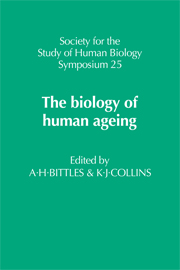Book contents
- Frontmatter
- Contents
- Preface
- Ageing as a consequence of natural selection
- Genetic information in ageing cells
- Insects as models for testing theories of ageing
- Human cell culture systems in the study of ageing
- Estimation of biological maturity in the older child
- Biological age assessment in adulthood
- Skeletal age and palaeodemography
- Cell death and the loss of structural units of organs
- The prospects for mortality decline and consequent changes in age structure of the population
- Where do old people come from? An evaluation of American population projections
- Age structure of Soviet population in the Caucasus: facts and myths
- The health of an ageing population
- Can we tell our age from our biochemistry?
- Dietary manipulation of ageing: an animal model
- Customary physical activity in the elderly
- Effects of ageing on human homeostasis
- Index
Skeletal age and palaeodemography
Published online by Cambridge University Press: 06 August 2010
- Frontmatter
- Contents
- Preface
- Ageing as a consequence of natural selection
- Genetic information in ageing cells
- Insects as models for testing theories of ageing
- Human cell culture systems in the study of ageing
- Estimation of biological maturity in the older child
- Biological age assessment in adulthood
- Skeletal age and palaeodemography
- Cell death and the loss of structural units of organs
- The prospects for mortality decline and consequent changes in age structure of the population
- Where do old people come from? An evaluation of American population projections
- Age structure of Soviet population in the Caucasus: facts and myths
- The health of an ageing population
- Can we tell our age from our biochemistry?
- Dietary manipulation of ageing: an animal model
- Customary physical activity in the elderly
- Effects of ageing on human homeostasis
- Index
Summary
INTRODUCTION
“The most reliable way of assessing the age of an individual from an anatomical point of view is by examination of the skeleton and the teeth. No other part of the body, however carefully examined, can give as much information. The younger a person is, the easier it is to assess age accurately from the bones.”
(Harrison, 1958.)It is widely accepted that expectation of life in the human species has increased not only in the last hundred years for which documentation exists but also for the thousands of years before that. It is equally accepted that human specific longevity, that is the maximum potential lifespan, has not increased, merely the number of people that die before reaching seventy has been reduced. Yet when we look at the age structure of cemetery populations of the mediaeval, Romano-British or Neolithic periods there is little sign of this older age group.
It is easy to calculate a constant 3% per annum death rate for a static, non-replacing population, and this shows that as much as 16% of the skeletons in a cemetery could be over 60 years of age. In reality, mortality rates vary with age and always there is an increase in the number of old dying. I think that we have to find this group before we can attempt any palaeodemographic reconstruction from cemetery material. Human mortality patterns are unlikely to have changed so radically. It is more probable that the fault lies with our methods. In this paper I should like to examine some of our methods of ageing skeletal material and discuss some of the premises that lie behind their acceptance.
- Type
- Chapter
- Information
- The Biology of Human Ageing , pp. 95 - 118Publisher: Cambridge University PressPrint publication year: 1986
- 6
- Cited by



